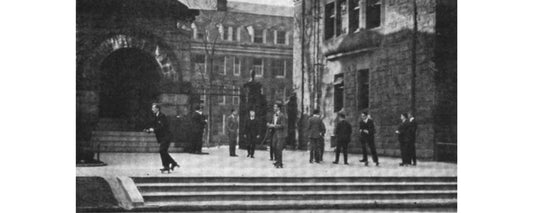This day in 1638, New Haven’s Puritan settlers arrived. Get to know them a little with this 17th-century story from 2017.
The Puritans who settled New Haven did so in part to worship as they pleased. But they weren’t necessarily willing to offer that freedom to others—especially Quakers, whose pacifism and egalitarianism were deeply heretical, and whose tactics were needling and disruptive.
In the 17th century, Quakerism—formally the Religious Society of Friends—espoused radical views that seem perfectly mainstream today. Though not without their own extreme pieties, early Quakers practiced civil disobedience, had female preachers and believed each person had an innate inner “light,” making anyone a candidate for heaven. They also rejected classist conventions, refusing to doff their hats in the presence of social superiors or give special deference to civic leaders and ministers.
sponsored by
Of course, Puritans believed and behaved very differently, and as towns like New Haven were settled by reverends and their flocks looking to establish what were effectively Zions, religious meaning and morality were woven into virtually every aspect of civic life. Laws were imposed limiting impious activities; women, not to forget racial and religious minorities, were thoroughly second-class; and, as some Quakers would discover firsthand, heresy could bring violent consequences.
In February of 1658, Humphrey Norton, an English Quaker, marched into a church in Southold, New York, where he harangued the minister and congregation. Located on Long Island, Southold had been settled by New Haveners, and the horrified people there sent Norton to the mother colony for judgement. Held outside in the winter for three weeks, Norton went to trial on March 10, where, after he tried to argue with the colony’s founding pastor John Davenport, a key was tied over his mouth, followed by a much worse punishment on the New Haven Green.
One account goes like this: “The Drum was Beat, the People gather’d, Norton was fetch’d and stripp’d to the Waste, and set with his back to the Magistrates, and given in their View Thirty-six cruel Stripes with a knotted cord, and his hand made fast in the Stocks where they had set his Body before, and burn’d very deep with a Red-hot Iron with H. for Heresie.” Norton was then cast out from the colony.
The event catalyzed the passage of anti-Quaker laws in New Haven. In Records of the colony or jurisdiction of New Haven, from May, 1653, to the union—“union” refers to 1664, when New Haven was absorbed into the Connecticut Colony—the local position of the time is made clear. On May 26, 1658, New Haven’s magistrates called Quakers “a cursed sect of heretics” and accused them of despising government, speaking “evil” to dignitaries and reproaching ministers. Anyone caught bringing a Quaker into the colony would be fined 50 pounds or imprisoned. The only way Quakers could legally visit New Haven was in the event that they had business to conduct, though they would have to register with the authorities. Should a Quaker try to sneak in or attempt to spread his or her beliefs, as Norton did in Southold, then the real horrors would begin.
For the first offense, “…they shall be committed to prison, severely whipped, put to work and none suffered to converse with them during their imprisonment.” (They would then be sent from the colony, albeit with whatever money they’d earned from their compulsory labor.) For the second, the branding irons would come out; as with Norton, the letter “H” would be branded on one hand, identifying the offender as a heretic. Upon a third offense, another branding would be placed on the opposite hand, and after a fourth, the offender would have their tongue driven through with a hot iron. Moreover, any books or writings found supporting Quakerism in a New Haven home would result in confiscation and questioning, and anyone caught hiding an actual Quaker in their home would be fined 20 shillings for each hour of harborage.
With this anti-Quaker code in place, another Quaker was caught at Southold and sent to New Haven in 1659. Arthur Smith, when questioned, stated that he didn’t believe in the devil, that his only master was God and that the concept of original sin was false. The court, finding his statements “profane, absurd, conceited and ridiculous,” had him whipped and fined 50 pounds.
Perhaps because the threat of Quaker meddling was smaller than believed, or perhaps because the laws were meant more to deter than to be enforced, New Haven applied its laws just three times total, with the other two cases ending with comparatively light sentences of censure and banishment. Harsher parallel laws in places like Boston, where four Quakers were executed between 1659 and 1661, helped create a backlash, including a condemnation of the practices by the newly restored King Charles II from his throne across the pond, that gradually ended the worst kinds of anti-Quaker persecution in America.
Not that England held the moral high ground. Persecution of religious minorities there was far worse than it was in New Haven, for one. According to The Death Penalty: A Reference Handbook (2017) by Joseph A. Melusky and Keith A. Pesto, it wasn’t until “the end of the 17th century in England… [that] there was a general end to using the death penalty to punish Catholics and other religious dissenters.”
Going beyond religious persecution specifically, Rollin G. Osterweis’s Three Centuries of New Haven (1953) notes the “persistent legend” that New Haven’s Puritans were especially harsh, then argues that the claim fails a critical test: even in 1656, after New Haven enacted its version of the infamously strict and pious “blue laws,” the colony named just 14 offenses punishable by death—a mere fraction of the number contained within the laws of England both before and after the Restoration.
If you aren’t comparing a historical society to its own contemporaries, Osterweis argues, then you aren’t fairly gauging its moral progress. New Haven’s laws in general were actually less draconian than those of most Puritan colonies, too, and its response to Quakerism, while highly intolerant in 21st-century terms, was meaningfully kinder than Boston’s, among many other examples.
In a context in which context matters, those early New Haveners managed to do their pluralistic descendants moderately proud.
Written by Anne Ewbank. Image depicts the flogging and tongue-boring of Quaker James Nailor in London, England, in 1656. This lightly updated story was originally published on October 12, 2017.








